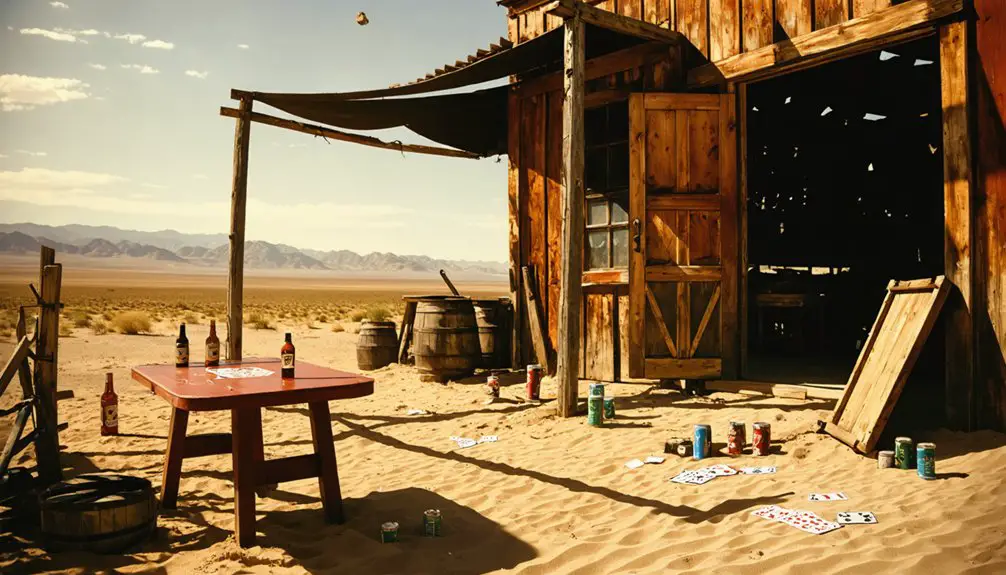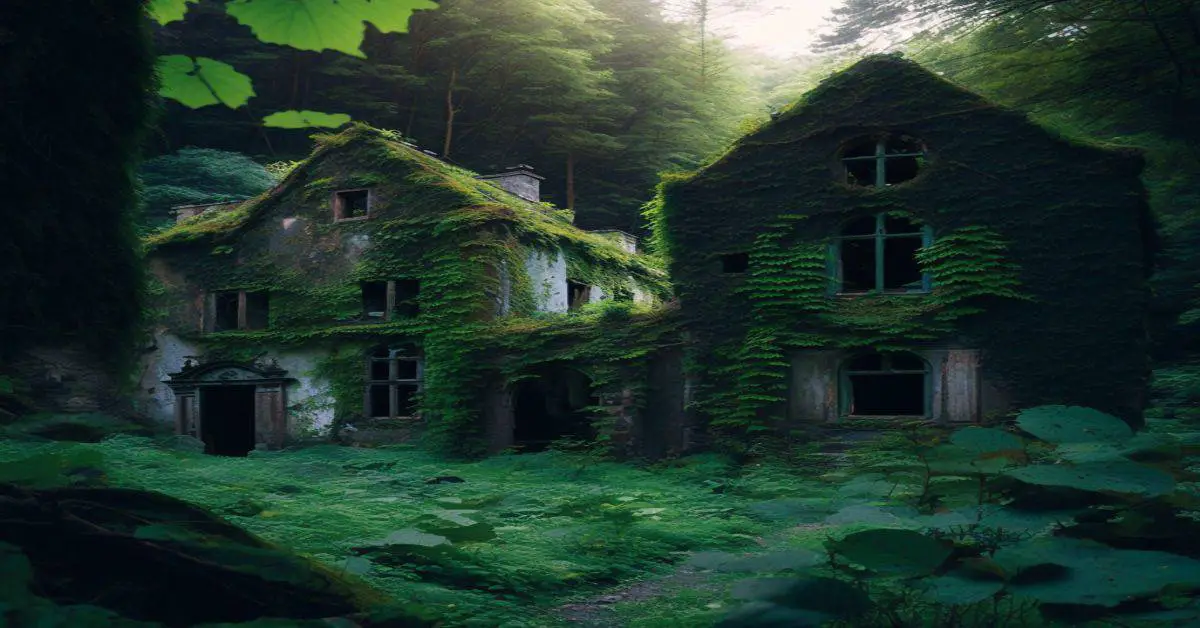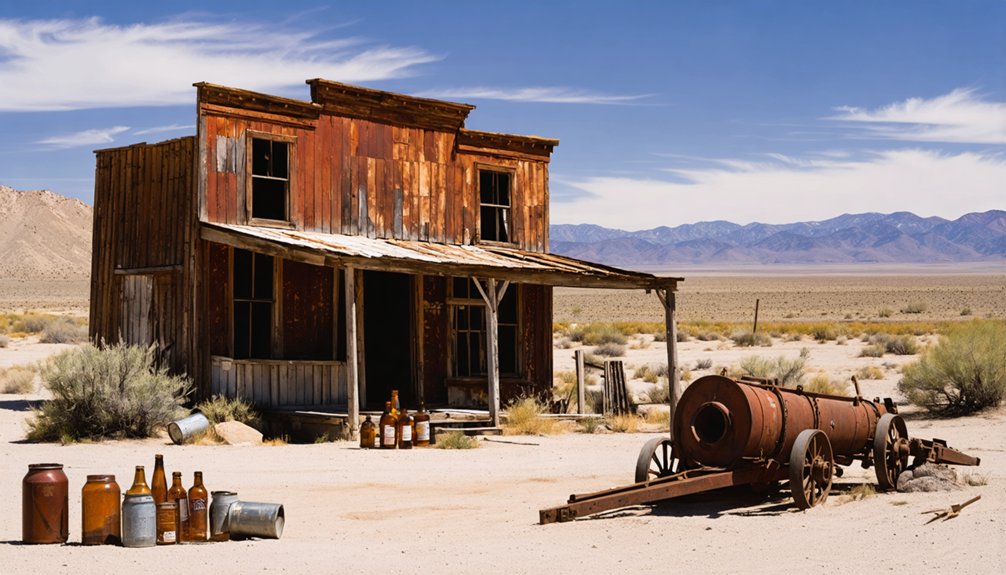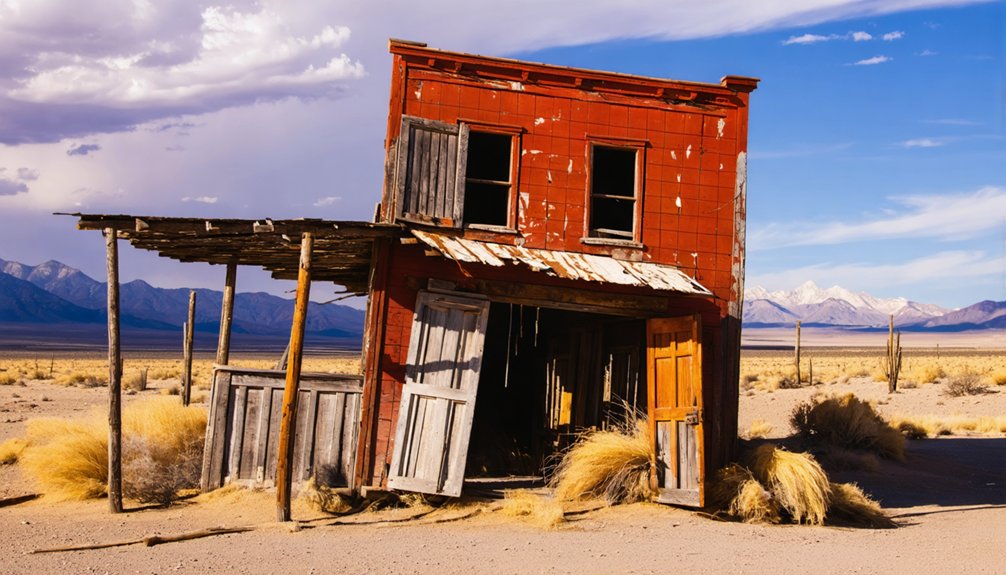You’ll find over 600 ghost towns scattered across Nevada, each telling the story of America’s most significant silver and gold rushes since 1849. Notable sites include Goldfield, once Nevada’s largest city, and Nelson’s El Dorado Mine near Las Vegas. For the best experience, visit during spring or fall with a 4WD vehicle, sturdy boots, and essential survival gear. These abandoned mining communities hold countless secrets waiting to be uncovered.
Key Takeaways
- Nevada has over 600 ghost towns, making it a premier destination for exploring abandoned mining settlements dating back to 1849.
- Visit during spring or fall for ideal weather conditions, and bring essential supplies including water, first-aid kit, and 4WD vehicle.
- Popular destinations include Goldfield (once Nevada’s largest city), Belmont (historic courthouse), and Nelson (commercialized ghost town tours).
- Many ghost towns feature unique architecture, like Rhyolite’s Bottle House built from 50,000 bottles and Goldfield Hotel’s early 1900s luxury.
- Prioritize safety by researching land ownership, obtaining permits, traveling in groups, and carrying proper navigation tools like GPS and maps.
The Legacy of Nevada’s Mining Boom Era
When Nevada’s modern mining era began in 1849 with the discovery of placer gold near Dayton, it set off a chain reaction that would transform the state’s landscape and economy.
The mining legacies you’ll discover across Nevada tell a story of dramatic booms and devastating busts, from the famous Comstock Lode‘s silver strike in 1859 to Tonopah’s rich deposits in 1900.
You’ll find the economic impacts of these mining ventures everywhere – in abandoned rail lines, vacant buildings, and silent mine shafts.
The completion of the transcontinental railroad in 1869 opened up Nevada’s mineral wealth, leading to hundreds of claims across the state.
The Native Americans had been mining these lands long before settlers arrived, using local minerals to create tools and weapons.
While some towns flourished during peak production years, many couldn’t survive the inevitable downturns that followed exhausted mines, economic recessions, and labor shortages through both World Wars. The precious metals industry saw a remarkable revival in 1965 when Newmont’s Carlin mine became Nevada’s largest gold producer.
Top Ghost Towns Worth Exploring
Where can you find the most fascinating remnants of Nevada’s mining era? Start with Goldfield, Nevada’s largest historic ghost town, where you’ll discover ghost town legends surrounding the Historic Cemetery’s Paste Eater’s Grave and distinct burial sections for Firemen, Freemasons, and Catholics.
During its peak years from 1905-1908, Goldfield was Nevada’s largest city with 20,000 residents.
The once-grand Goldfield Hotel stands as evidence of mining wealth.
Head to Belmont to explore wooden structures and the infamous courthouse featuring Charles Manson’s alleged graffiti.
For a commercialized experience, visit Nelson near Las Vegas, where you can tour the El Dorado Mine and examine restored buildings.
Experts warn that these historic sites will eventually disappear with time, so visiting sooner rather than later is recommended.
With over 600 ghost towns scattered across Nevada, you’ll find mining artifacts, foundational ruins, and weathered structures that tell stories of boom-and-bust cycles.
Visit between May and September when most sites are accessible.
Essential Planning Tips for Ghost Town Adventures
Before starting a Nevada ghost town adventure, you’ll need thorough preparation to explore these remote desert sites safely and legally.
Start by mapping your exploration logistics, considering that over 600 ghost towns are scattered across Nevada’s desert terrain. You’ll want a reliable 4WD vehicle and both GPS and physical maps, as cell service is often nonexistent.
Pack essential survival gear: plenty of water, first aid supplies, and protective clothing for extreme desert conditions. Be extra cautious around abandoned mine shafts that pose significant hazards to explorers.
Research land ownership and obtain necessary permits before visiting sites rich in ghost town history. For accommodations, check out updated miners’ shacks at historical locations like Gold Point that offer modern amenities and unique experiences. Consider timing your visit during spring or fall for ideal weather conditions.
When exploring, stick to established paths, avoid unstable structures, and never remove artifacts.
If possible, base yourself near towns with amenities or check out accommodations in preserved sites like Gold Point.
Historical Architecture and Notable Landmarks
You’ll find fascinating examples of mining-era architecture throughout Nevada’s ghost towns, from Pine Grove’s surviving stamp mill to Rhyolite’s innovative Bottle House constructed from thousands of glass bottles.
The region’s hotels showcase the wealth of the mining boom, with the grand Goldfield Hotel standing as one of the West’s most luxurious early 1900s establishments. Fort Churchill demonstrates impressive military construction with its partially restored buildings that now serve as centerpieces of a Nevada State Park.
Nevada’s ghost towns feature unique construction adaptations to desert conditions, including buildings made from local materials and structures designed to withstand extreme temperatures while serving multiple community functions, such as Pine Grove’s combination schoolhouse and community hall. The famous Cook Bank Building in Rhyolite stands as a testament to the architectural grandeur of Nevada’s mining heyday.
Mining-Era Building Techniques
The harsh Nevada environment shaped the distinctive architecture of mining-era ghost towns, where builders adapted their techniques to local conditions and available materials.
You’ll find timber framing dominated construction, with locally sourced wood used for most buildings due to its accessibility and ease of transport. In industrial structures like stamp mills, builders incorporated durable materials including corrugated metal roofing and stone foundations to withstand heavy machinery vibrations and protect against fire. These structures often supported mining boom communities that rapidly emerged around valuable mineral deposits.
Where timber was scarce, particularly in arid regions, you’ll discover adaptations using adobe and stone. Buildings were strategically oriented to combat intense heat and winds, while essential structures like offices and mills often featured brick construction. With over 600 ghost towns scattered across Nevada, these architectural remnants provide extensive examples of frontier building methods.
Many of these techniques proved so effective that surviving structures still stand as evidence of their durability.
Preserved Hotels and Courthouses
Among Nevada’s most impressive ghost town landmarks, preserved courthouses and hotels stand as monuments to the region’s prosperous mining era.
You’ll find the 1876 Belmont Courthouse anchoring its ghost town experience, while Goldfield’s 1907 sandstone courthouse, complete with original Tiffany lamps, maintains its architectural significance through active use.
The historic preservation of these structures tells compelling stories: Goldfield Hotel’s gold leaf ceilings and crystal chandeliers speak of bygone opulence, while Pioche’s Million Dollar Courthouse reflects the wild silver boom days.
In Pine Grove and Tunnel Camp, you can explore remarkably intact buildings that showcase mining-era construction.
These enduring landmarks, from Dirty Dick’s Belmont Saloon to the reportedly haunted Overland Hotel, offer authentic glimpses into Nevada’s rugged frontier past.
Unique Desert Construction Materials
When faced with scarce building materials in Nevada’s remote mining towns, early settlers demonstrated remarkable ingenuity through their creative use of desert resources. You’ll find fascinating examples like the 1905 Bottle House, constructed from 50,000 discarded beer and liquor bottles embedded in mud walls. This rare example of bottle architecture still stands as a symbol of frontier resourcefulness.
Throughout these ghost towns, you’ll discover structures built from local volcanic materials, particularly rhyolite rock, which provided durable foundations and walls against harsh desert conditions.
As railroad access improved, builders incorporated concrete and modern materials, though wood remained precious due to transport challenges. The California-Mission style train depot, with its distinctive stucco and tile roofing, marked these towns’ evolution from rugged camps to aspiring urban centers.
Tales From the Silver State’s Abandoned Past
Scattered across Nevada’s rugged landscape, over 600 ghost towns stand as silent witnesses to the state’s turbulent mining history since 1849.
You’ll find these abandoned settlements tell compelling ghost stories through their weathered structures and forgotten artifacts, from the famous Comstock Lode boomtowns to remote desert outposts.
Each site preserves unique elements of cultural heritage, whether it’s Nelson’s restored El Dorado Mine or Belmont’s historic courthouse with its Charles Manson connections.
While southern towns have largely succumbed to harsh desert conditions, northern settlements often retain more of their Wild West character.
You can explore everything from barren sites with mere foundations to semi-abandoned towns where a handful of residents still maintain their frontier legacy, offering glimpses into the boom-and-bust cycles that shaped Nevada’s destiny.
Photography and Exploration Guidelines
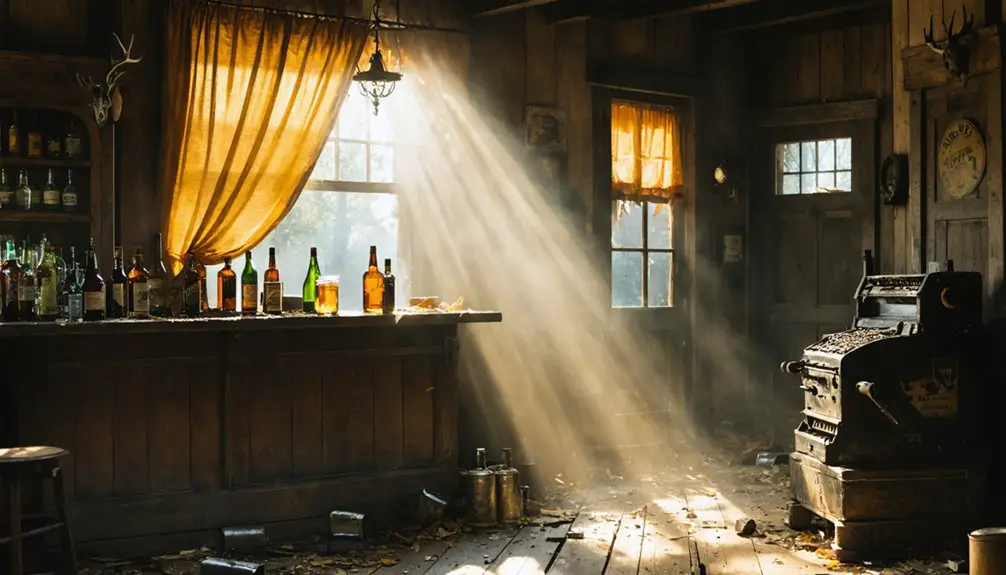
When exploring Nevada’s ghost towns, you’ll need to prioritize safety by traveling in groups, carrying plenty of water, and wearing protective clothing suitable for rugged terrain and extreme weather.
Your photography kit should include a sturdy tripod, wide-angle and zoom lenses, plus extra batteries and memory cards to capture the abundant historical subjects.
You’ll find the most success by photographing during early morning or late afternoon hours, particularly at popular locations like Nelson Ghost Town, where vintage cars and mining equipment provide compelling subjects in ideal lighting conditions.
Safety During Site Visits
Although ghost towns offer fascinating opportunities for photography and exploration, visitors must prioritize safety through careful preparation and awareness of potential hazards.
When planning your ghost town site visits, you’ll need to master essential navigation tools like maps, GPS, and compasses, as cell coverage is often nonexistent. For maximum ghost town safety, wear sturdy boots and protective clothing, and never enter abandoned mines or unstable structures.
Always travel with companions and inform others of your plans. Equip your vehicle with recovery gear and bring extensive first aid supplies.
Site visit precautions should include checking weather conditions, avoiding wildlife hazards like snakes, and steering clear of hazardous materials.
Remember to respect property boundaries and follow all preservation guidelines to guarantee both your safety and the site’s protection.
Best Photography Equipment Needed
Capturing the haunting beauty of Nevada’s ghost towns requires specific photography equipment that balances versatility with durability.
You’ll need a weather-sealed DSLR or mirrorless camera with full-frame capabilities to handle low-light conditions and harsh environments. Your lens selection should include wide-angle options for structural shots, standard zooms for versatility, and prime lenses for detail work.
Tripod stability is essential for achieving sharp images during long exposures, especially in dimly lit interiors.
Don’t forget essential support gear like headlamps, cleaning tools, and protective bags to shield your equipment from dust. Pack spare batteries and memory cards for extended shoots.
Consider bringing a macro lens for capturing intricate details of artifacts and a telephoto lens for architectural elements that aren’t safely accessible up close.
Best Times to Visit Nevada’s Ghost Towns
The ideal time to explore Nevada’s ghost towns falls between late spring and early fall, when perfect weather conditions and peak tourist services align.
You’ll find most attractions and shops fully operational during summer months, though you might encounter larger crowds during this peak season.
If you’re seeking solitude, plan your visit for early fall when temperatures remain pleasant and seasonal weather is stable.
Keep in mind that many towns, like Virginia City, wind down by mid-September, though some bed and breakfasts stay open year-round.
For “living” ghost towns like Jarbidge, you’ll find accessibility throughout the year, but remote locations require careful planning.
Always check road conditions and weather forecasts before heading out, especially for high-altitude destinations or isolated spots like Seven Troughs, where accessibility issues can arise from sudden storms.
Frequently Asked Questions
Are There Laws Against Taking Artifacts From Nevada Ghost Towns?
Like stealing candy from a baby, you’re breaking state regulations if you take artifacts from ghost towns. Nevada’s strict artifact preservation laws make removal without permits a gross misdemeanor or felony.
Can You Camp Overnight in Nevada’s Ghost Towns?
You can camp in most Nevada ghost towns on public land, but you’ll need to follow camping regulations like dispersed camping rules and camping etiquette, including Leave No Trace principles.
Which Ghost Towns Are Most Accessible for Visitors With Mobility Challenges?
While many ghost towns lack wheelchair accessibility due to historic preservation, you’ll find Scotty’s Castle and Death Valley’s Furnace Creek most accommodating, with Virginia City’s wooden boardwalks offering easier navigation for mobility-impaired visitors.
Are There Guided Tours Specifically Focused on Nevada Ghost Towns?
You’ll find several guided experiences led by established companies like Pilgrim Tours, Giftory, and Pink Adventure Tours, offering historical insights through ghost town tours ranging from day trips to week-long adventures.
What Wildlife Hazards Should Visitors Watch for in Ghost Town Areas?
While you’re seeking ghost town thrills, don’t become the ghost! Watch for rattlesnakes, scorpions, and spiders during wildlife encounters. Keep your distance from bats and protected desert tortoises for safe exploration.
References
- https://en.wikipedia.org/wiki/List_of_ghost_towns_in_Nevada
- https://www.visittheusa.com/experience/6-nevada-ghost-towns-explore-if-you-dare
- https://www.atlasobscura.com/things-to-do/nevada/ghost-towns
- https://nvtami.com/nevada-ghost-towns-map/
- https://travelnevada.com/ghost-town/
- https://nbmg.unr.edu/mining/MiningHistory.html
- https://nevadamining.org/new-history-page/
- https://www.visualcapitalist.com/sp/nevada-silver-districts/
- https://special.library.unlv.edu/boomtown/mining/
- https://www.britannica.com/place/Nevada-state/History
